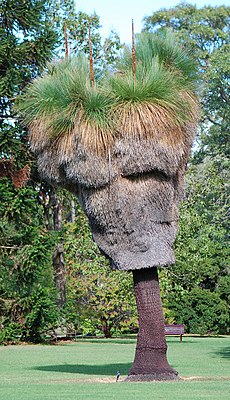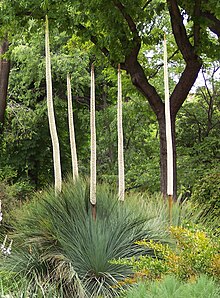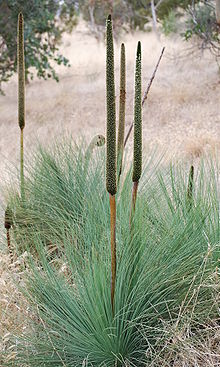Grass trees
| Grass trees | ||||||||||||
|---|---|---|---|---|---|---|---|---|---|---|---|---|

Xanthorrhoea malacophylla |
||||||||||||
| Systematics | ||||||||||||
|
||||||||||||
| Scientific name of the subfamily | ||||||||||||
| Xanthorrhoeoideae | ||||||||||||
| MWChase , Reveal & MFFay | ||||||||||||
| Scientific name of the genus | ||||||||||||
| Xanthorrhoea | ||||||||||||
| Sm. |
The grass trees ( Xanthorrhoea ) are the only plant genus of the subfamily Xanthorrhoeoideae in the family of the grass tree plants (Xanthorrhoeaceae s. L.) Within the order of the asparagus (Asparagales). The botanical genus name Xanthorrhoea is derived from the Greek xanthos for 'yellow' and rhoe for 'flow' and refers to the resin. English common names for this genus are "Yacca", "Blackboy" and "Grasstree". The family occurs only on the Australian continent, they are typical elements of the Australis . There are about 28 types.
description



Habit and leaves
Xanthorrhoea species are evergreen, xerophytic , perennial plants . The plants contain yellow, red or brown resin . Many species form a woody, sometimes poorly branched trunk over many years. In the other species, the shoot axis is largely underground and can be formed as a rhizome or tuber. There is anomalous secondary growth in thickness that occurs through a single cambium ring . Grass trees reach a height of 2 to a maximum of 6 meters and an age of up to 350 to 450 years (a radio-carbon age determination showed an age of 600 years). The height increase per year is only 0.8 to 6 cm (information determined only by a few individual studies by A. C. Borsboom 2005). The plant parts are mostly hairless.
The alternate and spirally, basal or terminal disposed on the stem in rosette leaves are simple and sessile. The leaf blade is narrow, linear, unifacial, grass-like, depending on the species, short to very long, leathery and parallel-veined. The smooth leaf edge has microscopic trichomes . The stomata are paracytic . The leaves stay green for about 2 to 3 years. Often parts of dead leaves remain on the trunk and are protection against evaporation and fire.
Inflorescences and flowers
Most Xanthorrhoea species form their first inflorescence at the earliest when they are 5 to 6 years old. Each species has a set flowering time. Terminally on mostly long Blütenstandsschäften are in composite total inflorescences from ährigen together many Flower Part inflorescences. There are support and cover sheets.
The relatively small, hermaphrodite flowers are radial symmetry and threefold. There are two circles with three free bracts each; they are different in the two circles, those of the outer circle are stiffer and shorter. There are two circles with three free, fertile stamens each; they are not fused with the bracts. The sulcate pollen grains have an aperture . The three carpels are an above-permanent (syncarp) ovary grown. Each of the three ovary chambers has three to eight anatropic , bitegmic , crassinucellate ovules . The stylus ends in a point, head-shaped or three-lobed scar. The Septal nectars produce a lot of nectar.
Fruits and seeds
Woody or cartilaginous, loculicidal capsule fruits are formed that contain three to six seeds. The seeds black due to Phytomelane have an oily endosperm . Some Xanthorrhoea species produce around 10,000 seeds per fruit cluster. The seeds remain viable for about 5 years.
Ingredients and chromosome number
There are calcium oxalate embedded crystals. The following ingredients are important: cyanidin , flavonols , kaempferol , quercetin and, in some species, proanthocyanidins . The number of chromosomes is uniformly 2n = 22.
ecology
Grass trees often form the undergrowth in Australian eucalyptus forests . Due to some properties, they survive the frequent bush fires in the Australian arid regions almost unscathed: Parts of the dead leaves protect the trunk. The pointed meristem survives fire because it is sunk.
The fires are even necessary for the grass trees to thrive because competing species are burned to form mineral nutrients. Many grass trees are pyrophytes , the spread and reproduction of which is promoted by fire. Their trunk is usually colored black by the soot from the fires (hence the common name "black boy").
Many hundreds of animal species have been observed on Xanthorrhoea species, but little is known about their interactions. However, some types of grass trees are poisonous to animals.


Systematics and distribution
The 28 or so Xanthorrhoea species are only found in all states of Australia and Tasmania . They thrive in temperate to tropical climates .
The molecular genetic investigations in the last ten years have led to the fact that the family boundaries within the order of the Asparagales have shifted significantly. The systematics of this genus, subfamily, family, has been discussed for a long time, so one will often encounter seeming inconsistencies in the literature. The systematics according to Mark W. Chase u. a. 2009. The Xanthorrhoeaceae Dum family. was extended to include the taxa of the former families of the Affodilla family (Asphodelaceae) and the daylily family (Hemerocallidaceae). Today the Xanthorrhoea form the only genus of the subfamily Xanthorrhoeoideae newly established in 2009 by Mark W. Chase, James L. Reveal & Michael F. Fay. The basionym for this subfamily is the family name Xanthorrhoeaceae, which was first published in 1829 by Barthélemy Charles Joseph Dumortier in Analyze des Familles de Plantes , 60, 62, 103.
The first publication of Xanthorrhoea is controversial: James Edward Smith published in 1797 in J. C. Dryander : Catalogus Bibliothecae Historico-Naturalis Josephi Banks , 3, 486 the species Xanthorrhoea hastilis Sm. , But it is disputed whether this publication is valid. Otherwise the valid first description was made in 1798 by James Edward Smith in The Characters of Twenty New Genera of Plants , in Transactions of the Linnean Society of London , 4, 219. Another (invalid) spelling of Xantorrhoea was published by L. Diels in Bot. Syst. 35, 1904, 104.
Here is a list of about 28 Xanthorrhoea species with their subspecies:
- Xanthorrhoea acanthostachya D.J.Bedford : It occurs in Western Australia .
- Xanthorrhoea acaulis (Atlee) DJBedford (Syn .: Xanthorrhoea australis subsp. Acaulis A.T.Lee ): It comes in New South Wales before.
- Xanthorrhoea arborea R.Br. : It occurs in New South Wales.
- Xanthorrhoea arenaria D.J.Bedford : It occurs in Tasmania .
- Xanthorrhoea australis R.Br. : It occurs in New South Wales, South Australia , Victoria and Tasmania.
- Xanthorrhoea bracteata R.Br. : It occurs in Tasmania.
- Xanthorrhoea brevistyla D.A. Herb. : It occurs in Western Australia.
-
Xanthorrhoea brunonis Endl. : It occurs with two subspecies in Western Australia:
- Xanthorrhoea brunonis Endl. subsp. brunonis
- Xanthorrhoea brunonis subsp. semibarbata D.J. Bedford
- Xanthorrhoea caespitosa D.J.Bedford : It occurs in South Australia and Victoria.
- Xanthorrhoea concava (Atlee) DJBedford (Syn .: Xanthorrhoea resinosa subsp. Concava A.T.Lee ): It occurs in New South Wales.
- Xanthorrhoea drummondii Harv. : It occurs in Western Australia.
- Xanthorrhoea fulva (Atlee) DJBedford (Syn .: Xanthorrhoea resinosa subsp. Fulva A.T.Lee ): It comes in Queensland before and New South Wales.
-
Xanthorrhoea glauca D.J.Bedford : There are two subspecies:
- Xanthorrhoea glauca subsp. angustifolia D.J.Bedford : It occurs in Queensland, New South Wales, Victoria and the Australian Capital Territory .
- Xanthorrhoea glauca D.J. Bedford subsp. glauca : It occurs in Queensland and New South Wales.
- Xanthorrhoea gracilis Endl. : It occurs in Western Australia.
- Xanthorrhoea johnstonii A.T. Lee : It occurs in Queensland and New South Wales.
-
Xanthorrhoea latifolia (ATLee) DJBedford : There are two subspecies:
- Xanthorrhoea latifolia (ATLee) DJBedford subsp. latifolia : It occurs in Queensland and New South Wales.
- Xanthorrhoea latifolia subsp. maxima D.J.Bedford : It occurs in Queensland and New South Wales.
- Xanthorrhoea macronema F. Muell. ex Benth. : It occurs in Queensland and New South Wales.
- Xanthorrhoea malacophylla D.J.Bedford : It occurs in New South Wales.
- Xanthorrhoea media R.Br. : It occurs in Queensland and New South Wales.
-
Xanthorrhoea minor R.Br. : There are two subspecies:
- Xanthorrhoea minor subsp. lutea D.J. Bedford : It occurs in South Australia and Victoria.
- Xanthorrhoea minor R.Br. subsp. minor : It occurs in New South Wales.
- Xanthorrhoea nana D.A. Herb. : It occurs in Western Australia.
- Xanthorrhoea platyphylla D.J.Bedford : It occurs in Western Australia.
- Xanthorrhoea preissii Endl. (Syn .: Xanthorrhoea reflexa D.A. Herb. , Xanthorrhoea pecoris F. Muell. ): It occurs in Western Australia.
- Xanthorrhoea pumilio R.Br. : It occurs in Queensland.
- Xanthorrhoea quadrangulata F. Muell. : It occurs in South Australia.
- Xanthorrhoea resinosa Pers. (Syn .: Xanthorrhoea hastilis R.Br. , Acoroides resinifera C.Kite , Xanthorrhoea hastile R.Br. orth. Var., Xanthorrhoea hastilis Sm. , Xanthorrhoea resinifera (Sol. Ex Kite) ECNelson & DJBedford nom. Inval.): It occurs in Victoria and New South Wales.
-
Xanthorrhoea semiplana F. Muell. : There are two subspecies:
- Xanthorrhoea semiplana F. Muell. subsp. semiplana : It occurs in South Australia.
- Xanthorrhoea semiplana subsp. tateana (F.Muell.) DJBedford (Syn .: Xanthorrhoea tateana F.Muell. ): It occurs in South Australia.
- Xanthorrhoea thorntonii Tate : It occurs in Western Australia, South Australia and the Northern Territory .
The genus Kingia was often assumed to also belong to this family group; however, it belongs to the Dasypogonaceae family .
use
The Australian natives (Aborigines) used Xanthorrhoea species in many ways. The name- giving yellow acaroid resin , which flows from the trunk, is used as an adhesive by the Aborigines. The flowers can be fermented into an alcoholic drink. In the 1920s , Paeonol was isolated from Xanthorrhoea tateana , later also from Xanthorrhoea arborea and Xanthorrhoea reflecta .
swell
- Mark W. Chase, James L. Reveal, Michael F. Fay: A subfamilial classification for the expanded asparagalean families Amaryllidaceae, Asparagaceae and Xanthorrhoeaceae. In: Botanical Journal of the Linnean Society , Volume 161, No. 2, 2009, pp. 132-136, doi: 10.1111 / j.1095-8339.2009.00999.x .
- The family of Xanthorrhoeaceae in APWebsite. (Section System and Description) viewed in April 2010
- The Xanthorrhoeaceae family at DELTA. (Section description)
- Leslie Watson: Xanthorrhoeaceae in the Western Australian Flora : online, 2008 .
- DJ Bedford: Xanthorrhoeaceae. In: Gwen J. Harden (Ed.): Flora of New South Wales , Volume 4, New South Wales Univ. Press, Kensington 1993, ISBN 0-86840-188-9 , pp. 61ff., (Html version online), limited preview in the Google Book search (section description)
- DJ Bedford: Xanthorrhoea . In: AS George (ed.): Flora of Australia Vol. 46: Iridaceae to Dioscoreaeceae , 1986, ISBN 0-644-04356-3 , pp. 148-169.
- AC Borsboom: Xanthorrhoea: A review of current knowledge with a focus on X. johnsonii and X. latifolia, two Queensland protected plants-in-trade. Wildlife Ecology Unit Environmental Sciences Division, EPA, 2005: ( PDF file )
Individual evidence
- ↑ Byron B. Lamont et al. a .: The Anatomy and Chemistry of the Color Band of Grasstree Stems (Xanthorrhoea Preissii) used for Plant Age and Fire History Determination. In: Annals of Botany. 89, 2002, pp. 605-612, online . (PDF; 574 kB), doi: 10.1093 / aob / mcf073 .
- ↑ AC Borsboom: Xanthorrhoea: A review of current knowledge with a focus on X. johnsonii and X. latifolia, two Queensland protected plants-in-trade. Wildlife Ecology Unit, Environmental Sciences Division, EPA, 2005: (PDF file).
- ↑ Angiosperm Phylogeny Group: An update of the Angiosperm Phylogeny Group classification for the orders and families of flowering plants: APG III. In: Botanical Journal of the Linnean Society. Volume 161, No. 2, 2009, pp. 105-121, doi: 10.1111 / j.1095-8339.2009.00996.x .
- ↑ a b Mark W. Chase, James L. Reveal, Michael F. Fay: A subfamilial classification for the expanded asparagalean families Amaryllidaceae, Asparagaceae and Xanthorrhoeaceae. In: Botanical Journal of the Linnean Society , Volume 161, No. 2, 2009, pp. 132-136, doi: 10.1111 / j.1095-8339.2009.00999.x .
- ↑ a b c d e f g h i j k l m n o p q r s t u v w x y z aa ab ac ad ae af ag ah ai aj ak al List of all names belonging to Xanthorrhoeaceae (valid and invalid ) are published at Australian Plant Name Index = APNI. last viewed on October 9, 2014
- ↑ On the use of the species: Aboriginal Uses of Native Plants from Australian National Botanic Gardens .
- ^ Xanthorrhoea australis at Plants For A Future
- ↑ Cheryll Williams: Medicinal Plants in Australia. Volume 1: Bush Pharmacy , Rosenberg, 2010, ISBN 978-1-877058-79-0 , p. 101.
Web links
- Australian Xanthorrhoeas. Retrieved November 22, 2014 .






